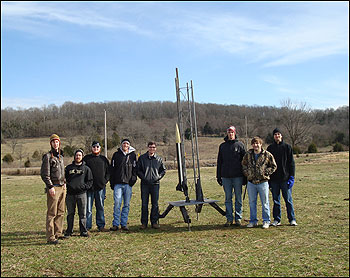Organizers of the NASA University Student Launch Initiative (USLI) have announced the student teams whose inventive creations will soar skyward in April during the space agency’s 2013 rocketry challenge.
This will be the seventh year the Vanderbilt Aerospace Club has been selected for the national competition, along with teams from MIT, Purdue, Georgia Tech, University of Illinois, North Carolina State, Mississippi State and University of Minnesota.
In all, 36 college and university teams will compete and a $5,000 first-place award provided by ATK Aerospace Group of Salt Lake City will go to the winner.
Vanderbilt teams have won several NASA USLI awards. In 2008 the team won the coveted 1-mile altitude competition. In 2010 the club’s scientific payload – thermoelectric generator for aerospace applications – received the Payload Design Award, and their website received the USLI web site award. The club and its adviser, professor of mechanical engineering A.V. Anilkumar, also received special awards from the Tennessee Section of the American Institute of Aeronautics and Astronautics (AIAA) for outstanding success at the USLI competition.

In 2011 and 2012 the club again won the Payload Design Award. In 2012 a combined team from the aerospace club and Peabody’s Department of Teaching and Learning won a prestigious outreach award from NASA – the 2012 Educational Engagement Award – for inspiring school students in the study of rocketry and other science, technology, engineering and mathematics (STEM) related topics.
Teams will design and build a large, high-powered rocket, complete with a working science or engineering payload and capable of flying to the target altitude of 1 mile. NASA created the rocketry challenge to encourage young people to pursue careers in STEM fields.
“Every year, the NASA Student Launch projects build on our students’ classroom studies in an energizing, exciting way,” said Tammy Rowan, manager of the Academic Affairs Office at NASA’s Marshall Space Flight Center in Huntsville, Ala., which organizes the event.
“It is great fun, but it also reflects the real-world complexity of planning missions, building flight hardware and completing tough pre-flight checks and reviews. It tests their problem-solving skills and gives them practical, hands-on experience. We hope the experience is so unforgettable it leads many of them to become the nation’s next generation of scientists, engineers and space explorers,” Rowan said.
“We are proud to be sponsoring NASA’s Student Launch Competition for the sixth year,” said Kent Rominger, a former astronaut who is vice president of business development for ATK’s Space Launch Division. “Each year we are impressed with the level of skill and knowledge these students exhibit. We are very optimistic and excited about the caliber of individuals that could become our future work force.”
Building the powerful rockets and designing and integrating the onboard engineering or science payloads are only two parts of the challenge. Teams also must maintain detailed preliminary and post-launch reports, and build and regularly update a public website to document their rocket-building experience. Each team also will develop an educational engagement program to inspire and educate younger students in their local school system and community.
In 2013 the teams will travel to Marshall Space Flight Center, where their rockets will undergo a series of intensive reviews and safety inspections – a smaller-scale version of the rigorous processes applied to the nation’s space vehicles.
The culmination of their work is set for April 21, when students launch their creations one by one into the skies over northern Alabama. Each will be seeking the elusive 1-mile altitude goal, as well as a variety of annual awards for vehicle design, payload design and engineering excellence.